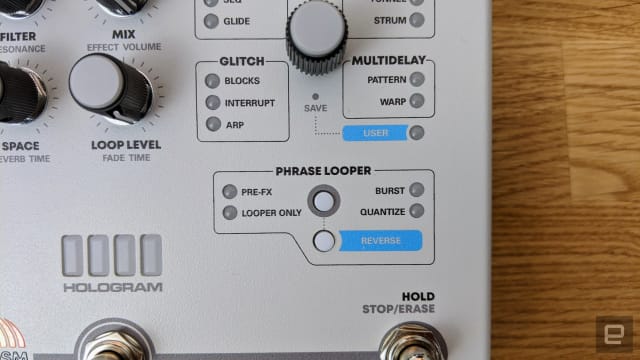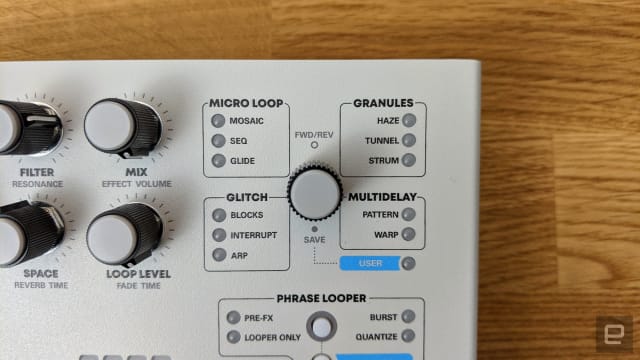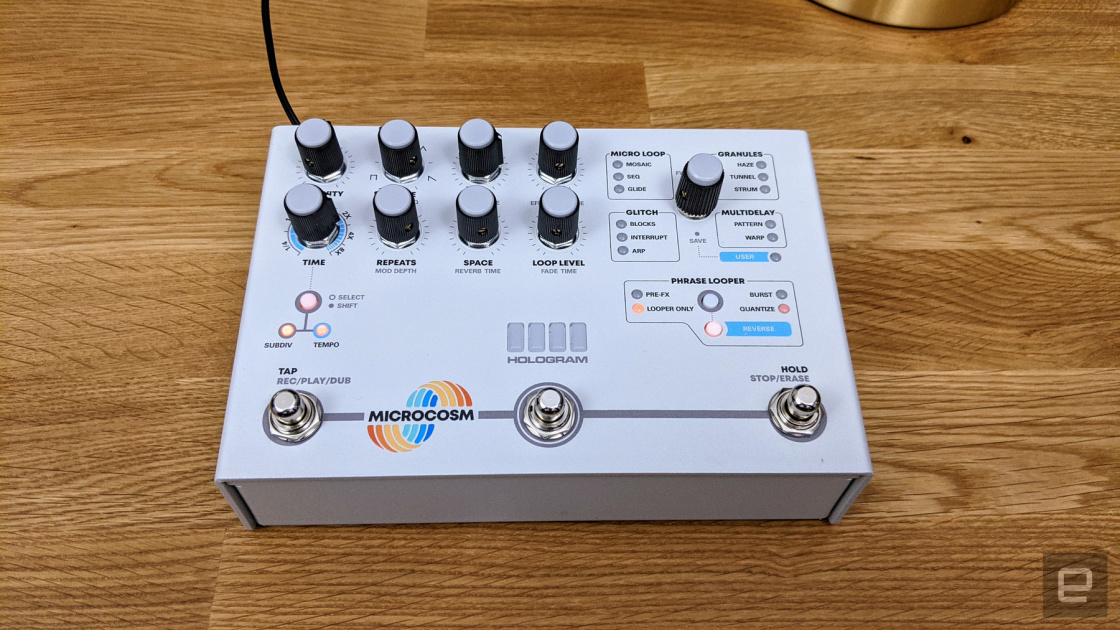Around the back, you’ll find the requisite audio ins and outs, along with 5-pin MIDI In and Out/Thru, and an expression pedal jack. My one complaint here is that the stereo input is a single TRS jack as opposed to separate right and left ones. This is fairly uncommon on synths and other guitar pedals and means you might need a TRS to dual TS cable to hook up your gear. On the plus side, Hologram Electronics includes a power adapter in the box, which almost no pedal manufacturers do anymore. (This turned out to be a real godsend since my cheapo pedalboard power supply introduced a lot of noise.)
There are a number of buttons, lights and knobs on the front that might seem a bit intimidating at first, but it’s easy to figure things out once you get going. The lone encoder on the right navigates through the various presets. Each effect lights up as it’s selected and the four lights above the middle footswitch (which turns the pedal on and off) indicate which particular preset of that effect you have selected. Those lights also show value levels, the direction of audio playback and are how you navigate the global menu.
The eight knobs to the left all have relatively clear primary and shift functions. (The secondary controls in light gray are accessed by holding down the shift button.) I say relatively because, while it’s fairly obvious what “mix” does, the “Activity” and “Repeats” controls are a little vague. The manual breaks it down pretty well, though:
“In general, Activity gives you ‘more’ or ‘less’ of what each preset does, and Repeats controls how long the effect goes on for.”
In short, they’re macro controls that aren’t mapped to one specific parameter and instead control a host of things depending on which effect you’ve chosen. They’re also highly interactive — meaning changes you make to Activity can impact the way the Repeats control behaves. A simple example of this would be in the Pattern effect which is a rhythmic multitap delay. Turning up the Activity increases the number of “taps” or delay lines. While Repeats controls the number of times each tap sounds. As you layer more delay lines on top of each other, and the more they repeat, they create new and increasingly complex rhythms until you reach complete chaos.
This level of interaction and depth also means the Microcosm feels just at home on a desktop as it does a pedalboard. While you can connect an expression pedal and perform some filter sweeps, the way it reacts when you start turning multiple knobs at once makes it feel like an instrument as much as an effect. In fact, it’s quite easy to record a simple loop through the Microcosm and build a full, rich and evolving arrangement simply by changing the parameters. It’s quite easy to get lost turning knobs as a loop plays, slowly pushing it towards a wash of ambiance.
The looper

Terrence O’Brien / Engadget
The looper is also an essential ingredient in what makes the Microcosm special. It’s feature packed and flexible. Ignoring everything else, the Microcosm is a great looper pedal. Once you activate it by pressing the phrase looper button the basic functions are straightforward: The left footswitch starts and stops recording, and adds overdubs. A long press undoes or redoes an overdub. The right footswitch stops playback when you tap it, and erases your loop if you hold it down. This is, more or less, the way any looper works.
From there, things get much more interesting. For one, you can quantize your recording and sync it either via tap tempo or MIDI. This can help avoid awkward gaps or stutters at your loop point, but more importantly, it syncs up with the pedals’ rhythmic effects to keep everything nice and cohesive. There’s also a button for quickly reversing your loop, plus speed control which can operate in a stepped mode (1/4X, 1/2X, 2X and 4X) or run smoothly from 1/4 speed to 4X speed. Most loopers I know of only do half-speed and double-speed, if they have speed controls at all.
Then there’s “Burst” mode, which records when pressing down the left footswitch and immediately starts playing when you let go. Pressing again erases your loop and starts capturing new audio. This mode definitely takes some getting used to, and I haven’t quite figured out the best way to take advantage of it, but it’s there.
One of the most unique features is the ability to place the looper either before or after the effects. This gives you the option of imprinting a loop with one effect and then recording a new line on top with a different one. Or recording a clean loop and changing effects after the fact to create a sense of evolution or to just audition different ones until you find what works best with a particular riff. Just one quirk to be aware of: Since user presets can actually include a pre-recorded loop, scrolling through them will stop playback. So, if you’re using the looper and changing effects in a live setting, just make sure to avoid the user banks.
There’s also a button labeled “looper only,” which disables the primary effects. This is key to the Microcosm’s versatility because it doesn’t disable the reverb, modulation or filter sections. This means you can use the Microcosm as a simple chorus, vibrato or reverb unit, or treat the filter section almost like a wah. That said, the voicing and sensitivity of the filter aren’t really suited to replacing a wah. One thing that would be nice here is the ability to define the range of an expression pedal because honestly, only the very top of the filter sweep is useful on a guitar.
I also wish there were an easy way to disable and enable the effects on the fly, rather than having to peck at tiny buttons. Being able to turn the granular effects on and off independent of the looper with a footswitch, or to be able to run the looper even when the pedal is off would be huge.
Since you can’t turn them on and off individually with footswitches, I wouldn’t just rely on the Microcosm’s built-in modulation and reverb, but they’ll definitely do in a pinch. Depending on the style of music you play, you could potentially take just this (and maybe a drive pedal) to a jam session and have everything you need. The control selection is limited to speed and depth on the modulation and “Space” on the reverb, but you get four different reverb types and they all sound excellent. They’re not always the most subtle, but considering the audience of experimental and ambient musicians, that’s not really an issue.
The effects

Terrence O’Brien / Engadget
Alright, so we’ve spent a lot of time talking about everything except the core effects here. We obviously can’t cover all 44 presets in detail, and frankly, that would get boring if we tried. But let’s start with the most straightforward: the two Multidelay options. They’re variations on a digital multitap delay. Pattern repeats those taps in various rhythmic combinations, while Warp manipulates the repeats with filtering and pitch shifting. These are perfect for spacey leads and solos, and work just as well with synths as guitars.
My favorite here is definitely mode two of the Warp preset, which puts a resonant bandpass filter on each tap. Depending on the settings it can be anything from a subtle glassy pad perfect for backing up some finger-plucked guitar, to a crisp ping that begs to be paired with percussion.
The Glitch section is the hardest to tame, but also rewarding when you do. More so than many of the other presets you have to play to the Glitch effects, responding to them in real time. Arp is probably the most aggressive at dismantling your original signal. It chops up the incoming audio and spits out an arpeggio. Turning up the activity knob here increases the number of steps in the arpeggio and the different modes introduce additional effects like random filtering and bit crushing. The bit crushed fourth mode can turn even the cleanest guitar into a crunchy synth bass.
You’ll probably want to use a clean-ish guitar for Arp effects too, (as well as many of the Micro Loop modes). While a firmware update in August improved tracking and triggering for synths and distorted guitar, it can still struggle if an effect demands extreme precision to trigger properly. This really only affects heavily distorted signals, though. If you’ve got a touch of overdrive running that’s not an issue. But super fuzzy guitar or droney synth chords can cause problems.
Here Mosaic mode one is creating a doubling / harmonized effect on the guitar.
My favorite of the Glitch effects is Interrupt. As the name suggests, it interrupts your dry signal with various glitchy bursts of noise. To get the full impact you need to turn the mix up to 100 percent wet. And by far the most fun I had with the Microcosm was ripping solos in mode one of Interrupt, which introduces CD-skipping like stutters. Like I said, this pedal excels at ambiance and drones, but it’s capable of much more.
The Micro Loop modes are a cross between the Glitch and Multi delay effects. If you’re familiar with pedals like Chase Bliss Audio’s Mood or Montreal Assembly’s Count to Five, you should have a general idea of what to expect here. Short snippets of your playing are captured, looped and manipulated in various ways. Glide creates pitch bends, while Seq spits out new rhythmic patterns that aren’t dissimilar from the sounds you’d find in Arp mode.
Then there’s Mosaic, which I’d argue is the best representation of what the Microcosm is all about. It’s simple short loops played back at varying speeds creating pitched effects. While you can use it on almost anything effectively, including percussion, it shines with clean plucked guitar melodies and sparse piano chords.
Mode one can add a gentle sparkle underneath a pad, while mode two can introduce an almost bass-like counterpoint to a guitar line. As for mode four, it can erupt in almost cartoonish showers of sparkles at more extreme settings. While I think Mosaic is at its best when you can still hear the individual loops as they bounce off each other creating new melodies and rhythms, completely washing them out with the built-in reverb creates gorgeous synth-like drones.
Lastly, there’s the Granules section, which delivers the sort of sounds people usually imagine when they think of “granular.” Haze is all about textures and pads, while Tunnel is perfect for building epic drones. These can be subtle almost reverb-like backdrops or can completely replace the source audio with cinematic soundscapes.
The Strum effect is the one I struggled with the most. It repeats note onsets to create rhythmic textures, but the results can be unpleasant and harsh without a decent amount of reverb. Now, the fact that I didn’t immediately click with this particular effect isn’t a knock against the Microcosm. I still managed to find sounds I liked among its presets. But, even if I didn’t — even if I disliked all four of them — there are 43 others on here. That’s still a .909 batting average.
This article is auto-generated by Algorithm Source: www.engadget.com


